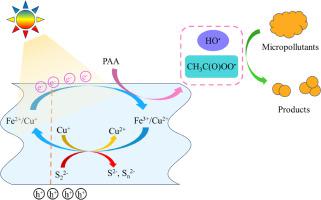当前位置:
X-MOL 学术
›
Water Res.
›
论文详情
Our official English website, www.x-mol.net, welcomes your feedback! (Note: you will need to create a separate account there.)
Photo-assisted natural chalcopyrite activated peracetic acid for efficient micropollutant degradation
Water Research ( IF 12.8 ) Pub Date : 2024-04-30 , DOI: 10.1016/j.watres.2024.121699 Linqian An , Xiujuan Kong , Maoju Jiang , Wenqi Li , Qixiao Lv , Xiangyang Hou , Chenlong Liu , Peng Su , Jun Ma , Tao Yang
Water Research ( IF 12.8 ) Pub Date : 2024-04-30 , DOI: 10.1016/j.watres.2024.121699 Linqian An , Xiujuan Kong , Maoju Jiang , Wenqi Li , Qixiao Lv , Xiangyang Hou , Chenlong Liu , Peng Su , Jun Ma , Tao Yang

|
The effective activation of natural chalcopyrite (CuFeS) on peracetic acid (PAA) to remove organic micropollutants was studied under visible light irradiation. Results showed than an effective sulfamethoxazole (SMX) degradation (95.0 %) was achieved under visible light irradiation for 30 min at pH 7.0. Quenching experiments, electron spin resonance analysis, and LC/MS spectrum demonstrated that HO and CHC(O)OO were the main reactive species for SMX degradation, accounting for 43.3 % and 56.7 % of the contributions, respectively. Combined with X-ray photoelectron spectroscopy analysis, the photoelectrons generated on CuFeS activated by visible light enhanced the Fe/Fe and Cu/Cu cycles on the surface, thereby activating PAA to generate HO/CHC(O)OO. The removal rate of SMX decreased with the increase in wavelengths, due to the formation of low energy photons at longer wavelengths. Besides, the optimal pH for degradation of SMX by CuFeS/PAA/Vis-LED process was neutral, which was attributed to the increasing easily activated anionic form of PAA during the increase in pH and the depletion of Fe species at alkaline conditions. Cl, HCO, and HA slightly inhibited SMX degradation because of reactive species being quenched and/or shielding effect. Furthermore, the degradation efficiency of different pollutants by CuFeS/PAA/Vis-LED was also measured, and the removal efficiency was different owing to the selectivity of CHC(O)OO. Finally, the process exhibited good applicability in real waters. Overall, this study provides new insight into visible light-catalyzed activation of PAA and suggests on further exploration of the intrinsic activation mechanism of PAA.
中文翻译:

光辅助天然黄铜矿活化过乙酸可有效降解微污染物
研究了可见光照射下天然黄铜矿(CuFeS)对过乙酸(PAA)的有效活化去除有机微污染物。结果表明,在 pH 7.0 的可见光照射下 30 分钟,磺胺甲恶唑 (SMX) 被有效降解 (95.0%)。淬灭实验、电子自旋共振分析和LC/MS谱表明H2O和CHC(O)OO是SMX降解的主要反应物种,分别占贡献的43.3%和56.7%。结合X射线光电子能谱分析,可见光激活的CuFeS上产生的光电子增强了表面的Fe/Fe和Cu/Cu循环,从而激活PAA生成HO/CHC(O)OO。由于在较长波长下形成低能光子,SMX 的去除率随着波长的增加而降低。此外,CuFeS/PAA/Vis-LED 过程降解 SMX 的最佳 pH 值为中性,这归因于在碱性条件下 pH 值增加和 Fe 物种消耗期间,PAA 易激活的阴离子形式增加。由于活性物质被猝灭和/或屏蔽效应,Cl、HCO 和 HA 轻微抑制了 SMX 降解。此外,还测量了CuFeS/PAA/Vis-LED对不同污染物的降解效率,由于CHC(O)OO的选择性,去除效率有所不同。最后,该过程在实际水域中表现出良好的适用性。总的来说,这项研究为可见光催化PAA的激活提供了新的见解,并为进一步探索PAA的内在激活机制提供了建议。
更新日期:2024-04-30
中文翻译:

光辅助天然黄铜矿活化过乙酸可有效降解微污染物
研究了可见光照射下天然黄铜矿(CuFeS)对过乙酸(PAA)的有效活化去除有机微污染物。结果表明,在 pH 7.0 的可见光照射下 30 分钟,磺胺甲恶唑 (SMX) 被有效降解 (95.0%)。淬灭实验、电子自旋共振分析和LC/MS谱表明H2O和CHC(O)OO是SMX降解的主要反应物种,分别占贡献的43.3%和56.7%。结合X射线光电子能谱分析,可见光激活的CuFeS上产生的光电子增强了表面的Fe/Fe和Cu/Cu循环,从而激活PAA生成HO/CHC(O)OO。由于在较长波长下形成低能光子,SMX 的去除率随着波长的增加而降低。此外,CuFeS/PAA/Vis-LED 过程降解 SMX 的最佳 pH 值为中性,这归因于在碱性条件下 pH 值增加和 Fe 物种消耗期间,PAA 易激活的阴离子形式增加。由于活性物质被猝灭和/或屏蔽效应,Cl、HCO 和 HA 轻微抑制了 SMX 降解。此外,还测量了CuFeS/PAA/Vis-LED对不同污染物的降解效率,由于CHC(O)OO的选择性,去除效率有所不同。最后,该过程在实际水域中表现出良好的适用性。总的来说,这项研究为可见光催化PAA的激活提供了新的见解,并为进一步探索PAA的内在激活机制提供了建议。






























 京公网安备 11010802027423号
京公网安备 11010802027423号